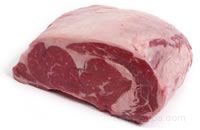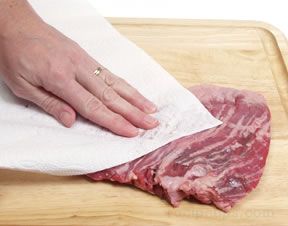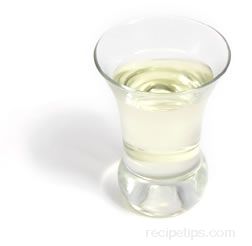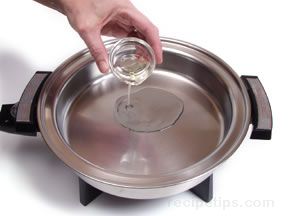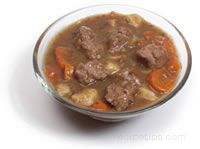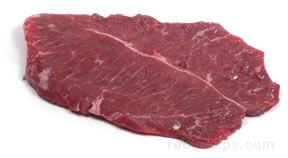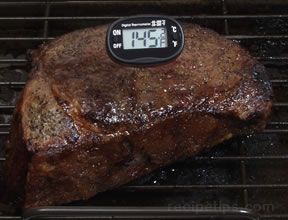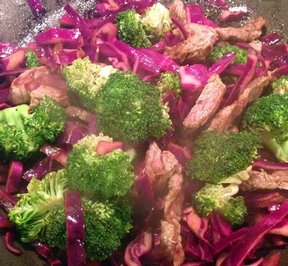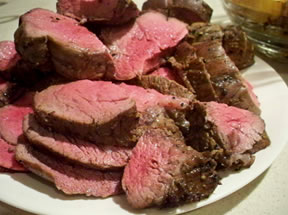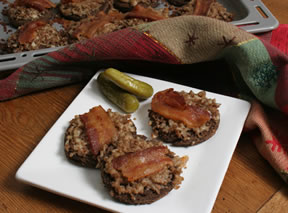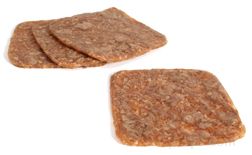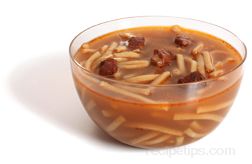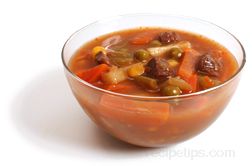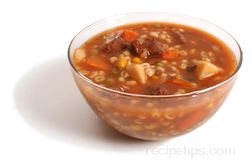Oven-Broiling | Pan-Broiling
|
Broiling is much like grilling in that food is cooked directly with high heat. The difference between broiling and grilling is that broiling is usually done in an oven and the heat source is above the food (except when pan-broiling) whereas grilling is done on equipment that is generally used outdoors and the heat source is below the food. (As described in "Grilling Beef", there are also indoor grills such as portable electric models for the countertop and stoves with built-in grills). |
| Beef for broiling should be tender with adequate marbling and since the goal is to cook the meat quickly, it should not be too thick. Beefsteaks that are no thicker than one inch are excellent for broiling, especially tender steaks from the rib and the loin including the rib-eye, tenderloin, boneless top loin, Porterhouse, T-bone, and top boneless sirloin. Steaks cut from the chuck can be quite good if not overcooked. Round steaks are not ideal choices for broiling, but they can be greatly improved if they are marinated first. |
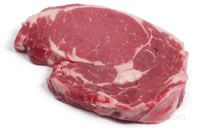 |
Oven-Broiling
|
Oven-Broiling Steps
- Before broiling cuts of beef, it is beneficial to remove the meat from refrigeration for a few minutes to warm it slightly, however the meat should not be allowed to remain at room temperature for an extended period. It may be difficult to broil well-chilled beef properly if the meat is placed immediately into the broiler from the refrigerator. It is possible that the outer portion of the meat may be fully cooked and begin to char before the interior portion reaches the proper doneness.
- If a beefsteak has a thick layer of fat on the outside edges, it should be trimmed off so that only about 1/8" of fat remains. A little bit of fat around the edges helps to seal in the juices and keeps the edges from drying out when the meat is broiled. The remaining fat layer should be vertically slashed at one inch intervals around the perimeter of the steak to help prevent the meat from curling due to the heat of the broiler. This also helps to prevent excess spattering and smoking during the broiling process.
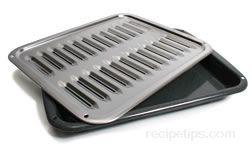
- When beef is grilled, it is generally placed directly on the grilling rack, but when beef is broiled, it is placed on a broiling pan. The broiling pan catches melting fat and juices that drip from the beef as it cooks so that the oven stays cleaner. It also prevents the fat from starting an oven fire.
- Oven racks should be adjusted to allow for the height of the broiler pan and the thickness of the meat, which should be about 3 to 6 inches from the heat source. The broiler oven should be preheated at the highest temperature setting for 10 to 15 minutes. The broiler pan should be preheated under the broiler for several minutes before the beef is placed on it.
- Beef cuts should be brushed with oil before they are placed on the broiling pan to prevent sticking when they are cooked. Meat that has been marinated in any mixture containing oil can be placed on the pan without additional oiling.
- When broiling beef, the meat is usually cooked on one side, turned once, and cooked on the other side. When turning the meat, a tongs should be used to avoid puncturing the meat and allowing juices to escape. The meat should be watched closely to ensure that it does not become charred and burned. The goal is to produce beef with a brown, crusty surface and an interior that is juicy and tender.
Note: Most recipes for broiled beef also work
well when grilling, but the cooking times may vary. |
Pan-Broiling
| Pan-broiling is a useful variation of oven-broiling in which the surface of the hot pan becomes the heat source. It doesn't require heating up the oven and allows for easier monitoring of the cooking process. Pan-broiling works especially well for beefsteaks. |
|
Pan-Broiling Steps

- Heat a heavy bottomed pan until it's hot enough to evaporate a drop of water instantly.
- Sprinkle a little salt over the surface of the pan. This helps make a tasty crust on the meat and doesn't add a significant amount of salt to the food. (You can omit this step and still get good results).
- The beef should sizzle as soon as it is placed into the pan. The meat should be browned well on one side and then turned to brown the other side.
- When turning the meat, a tongs or spatula should be used to avoid puncturing the meat, allowing juices to escape.
- If the meat requires longer cooking at this point, reduce the heat somewhat to prevent burning. If the meat will not be served immediately, cover the pan to hold in moisture.
|










